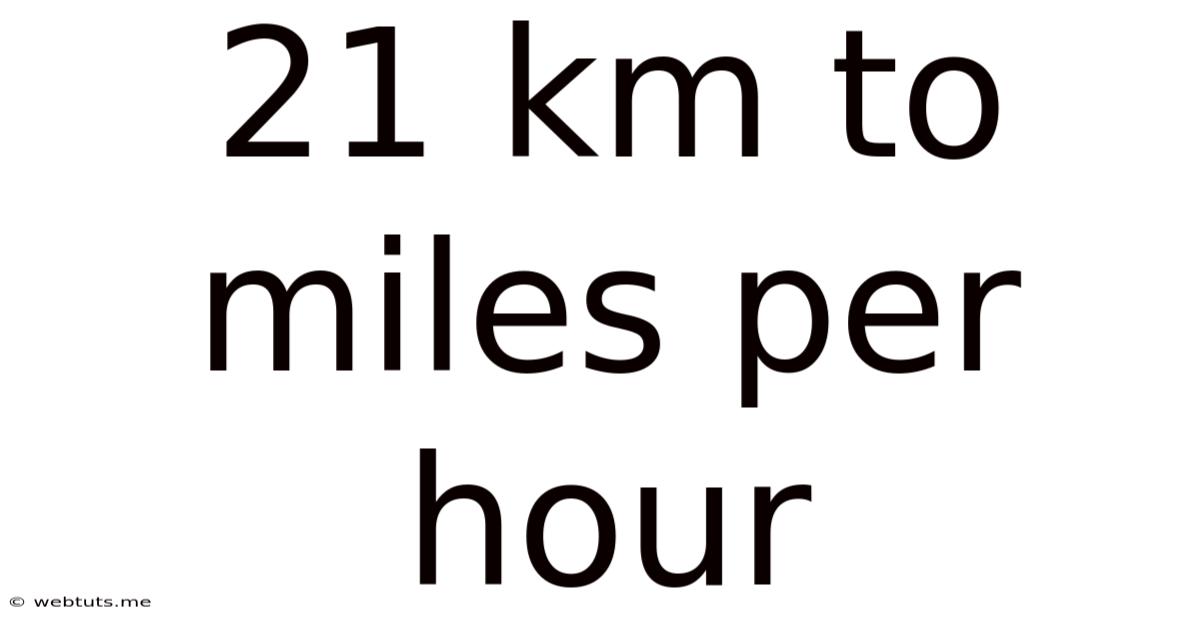21 Km To Miles Per Hour
Webtuts
May 13, 2025 · 4 min read

Table of Contents
Decoding the Conversion: 21 km to Miles Per Hour – Understanding Speed and Distance
The question "how many miles per hour is 21 km?" might seem straightforward, but it reveals a crucial misunderstanding about units of measurement and their application in describing speed. 21 km represents distance, not speed. Miles per hour (mph) represents speed, specifically the distance covered in one hour. Therefore, a direct conversion isn't possible without additional information. This article will delve into the intricacies of this conversion, explaining the concepts of speed, distance, and time, and showing how to correctly calculate speed given a distance and a time frame.
Understanding the Fundamentals: Speed, Distance, and Time
Before we attempt any conversions, let's solidify our understanding of the fundamental concepts involved:
-
Distance: This is the length covered between two points. It can be measured in kilometers (km), miles (mi), meters (m), feet (ft), and numerous other units. In our case, we're given a distance of 21 km.
-
Time: This is the duration it takes to cover a certain distance. It's measured in hours (hr), minutes (min), seconds (sec), etc. Crucially, we're missing the time component in the initial question. Without knowing the time taken to travel 21 km, we cannot calculate the speed.
-
Speed: This is the rate at which distance is covered over time. It's calculated as Speed = Distance / Time. The common units for speed include kilometers per hour (km/h), miles per hour (mph), meters per second (m/s), and others.
The Missing Piece: Time
To convert 21 km to mph, we need to know the time taken to travel those 21 kilometers. Let's illustrate with a few examples:
Example 1: Traveling 21 km in 30 minutes
- Distance: 21 km
- Time: 30 minutes = 0.5 hours (remember to convert minutes to hours for consistent units)
Now we can calculate the speed:
Speed = Distance / Time = 21 km / 0.5 hr = 42 km/h
To convert this to mph, we use the conversion factor 1 mile ≈ 1.609 km:
Speed in mph = 42 km/h * (1 mi / 1.609 km) ≈ 26.1 mph
Example 2: Traveling 21 km in 1 hour
- Distance: 21 km
- Time: 1 hour
Speed = Distance / Time = 21 km / 1 hr = 21 km/h
Converting to mph:
Speed in mph = 21 km/h * (1 mi / 1.609 km) ≈ 13.0 mph
Example 3: Traveling 21 km in 2 hours
- Distance: 21 km
- Time: 2 hours
Speed = Distance / Time = 21 km / 2 hr = 10.5 km/h
Converting to mph:
Speed in mph = 10.5 km/h * (1 mi / 1.609 km) ≈ 6.5 mph
These examples clearly demonstrate that the speed in mph varies drastically depending on the time taken to cover the 21 km distance. A faster journey results in a higher speed, while a slower journey results in a lower speed.
The Importance of Units and Conversions
The accuracy of any speed calculation hinges on the correct use of units. Always ensure that your distance and time units are consistent before performing the calculation. If you're given distance in kilometers and time in minutes, convert the time to hours before calculating the speed in km/h. Then, use the appropriate conversion factor (1 mile ≈ 1.609 kilometers) to convert to mph.
Practical Applications and Real-World Scenarios
Understanding the relationship between distance, time, and speed has numerous practical applications:
- Driving: Calculating average speed on a road trip, estimating travel time, determining fuel efficiency.
- Running: Tracking pace during a race, monitoring training progress, setting realistic goals.
- Cycling: Planning routes, assessing fitness levels, comparing performance against others.
- Aviation: Calculating flight times, determining fuel requirements, navigating airspaces.
- Navigation: Estimating travel times using GPS, calculating distances between locations.
Beyond Simple Conversions: Advanced Considerations
While the basic conversion from km/h to mph is relatively straightforward, several other factors can influence the interpretation of speed:
-
Average vs. Instantaneous Speed: The calculations above provide the average speed over the entire journey. Instantaneous speed refers to the speed at a specific moment in time, which can fluctuate throughout the journey.
-
Variations in Terrain: Speed can be affected by uphill and downhill gradients, as well as road conditions (e.g., smooth highway vs. rough terrain).
-
Traffic and Obstacles: Unexpected delays due to traffic congestion, road closures, or other obstacles can significantly impact travel time and average speed.
-
Wind and Weather Conditions: Headwinds can slow down travel, while tailwinds can increase speed, particularly in activities like cycling or aviation.
Conclusion: Context is Key
The seemingly simple question of converting 21 km to mph highlights the importance of understanding the underlying concepts of speed, distance, and time. Without the crucial information regarding travel time, a direct conversion is impossible. Always ensure you have all the necessary information before attempting a conversion and remember to maintain consistent units throughout your calculations. Mastering these concepts is essential for numerous applications in daily life and various fields. The examples provided here offer a practical framework for understanding and applying these principles. Remember that context is always key in interpreting speed and distance data.
Latest Posts
Latest Posts
-
How Many Days Until Sept 19 2024
May 13, 2025
-
How Many Days Til May 27
May 13, 2025
-
How Many Pounds Is 6 5 Kg
May 13, 2025
-
24 Fluid Ounces How Many Cups
May 13, 2025
-
30 Days From December 10 2024
May 13, 2025
Related Post
Thank you for visiting our website which covers about 21 Km To Miles Per Hour . We hope the information provided has been useful to you. Feel free to contact us if you have any questions or need further assistance. See you next time and don't miss to bookmark.